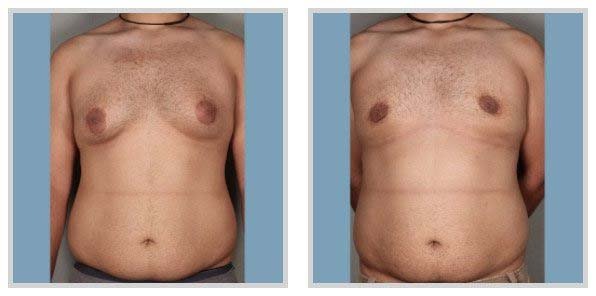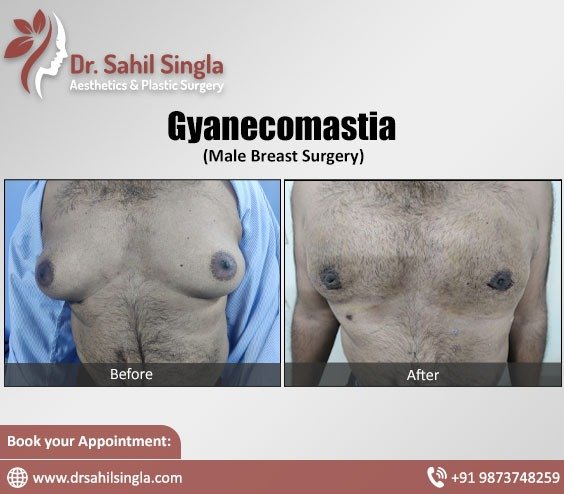Dr. Sahil Singla is a qualified plastic surgeon who specializes in gynecomastia surgery in East Delhi. He has extensive experience in performing gynecomastia surgery in Delhi and is known for his expertise in this field.
Dr. Singla uses the latest surgical techniques and equipment to ensure the best possible outcomes for his patients. He provides personalized care and attention to each patient and works closely with them to achieve their desired results.
If you are considering gynecomastia surgery in Delhi, Dr. Sahil Singla may be a good option for you to consider.
Gynecomastia is a condition where men develop breast tissue. It is a common condition that affects many men, but it is often ignored or misunderstood. Many men feel embarrassed or ashamed to talk about it, which can make it difficult to seek treatment. However, it is essential to understand that gynecomastia is a medical condition that requires proper diagnosis and treatment.
What is Gynecomastia?
Gynecomastia is a condition where the breast tissue in men swells and becomes larger than normal. It is caused by an imbalance of hormones, specifically an increase in estrogen levels or a decrease in testosterone levels. It can affect one or both breasts and can occur at any age. Gynecomastia is a common condition, affecting up to 70% of adolescent boys and up to 50% of adult men.

What are the Symptoms of Gynecomastia?
Symptoms of gynecomastia may include swelling, tenderness, and nipple discharge. In some cases, the condition may also be accompanied by pain or a lump in the breast tissue. Gynecomastia can affect men of all ages and can be caused by a variety of factors, including hormonal imbalances, medications, and certain medical conditions.
What Causes Gynecomastia?
A variety of factors, including hormonal imbalances, medications, and certain medical conditions can cause gynecomastia. Some common causes and risk factors of gynecomastia include:
- Hormonal changes: Gynecomastia can occur when there is an imbalance between the hormones estrogen and testosterone in the body. This can happen during puberty, in older men, or in men with low testosterone levels.
- Medications: Certain medications, such as anti-androgens, anabolic steroids, and some antidepressants, can cause gynecomastia.
- Medical conditions: Gynecomastia can be a symptom of certain medical conditions, such as liver disease, kidney failure, and thyroid disorders.
- Illegal drugs and alcohol: The use of illegal drugs like marijuana, and excessive alcohol consumption can increase the risk of developing gynecomastia.
- Genetics: Gynecomastia can sometimes be inherited or passed down through families.
- Obesity: Being overweight or obese can increase the risk of developing gynecomastia.
- Age: Gynecomastia is more common in older men due to a decrease in testosterone levels.
It is important to note that not all cases of gynecomastia have an identifiable cause, and in such cases, it may be referred to as idiopathic gynecomastia.
Diagnosis and Assessment
Diagnosis and assessment of gynecomastia usually involve a combination of medical history, physical examination, and diagnostic tests. The process may include the following steps:
- Medical history: The doctor will ask questions about the patient’s symptoms, medical history, medications, and family history.
- Physical examination: The doctor will perform a physical examination to check for signs of gynecomastia, such as breast tissue swelling, tenderness, or discharge.
- Diagnostic tests: The doctor may order diagnostic tests such as blood tests or imaging studies to help determine the cause of gynecomastia. These tests may include hormone level tests, mammograms, or ultrasounds.
- Differential diagnosis: The doctor may rule out other conditions that can cause breast enlargement in men, such as breast cancer or fat deposition.
- Severity assessment: The doctor may use a severity grading system to determine the extent of breast tissue enlargement and evaluate the need for treatment.
The diagnostic process may vary depending on the individual case and the underlying cause of gynecomastia. It is important for patients to consult with Dr Sahil Singla, the best plastic surgeon in Delhi, for an accurate diagnosis and appropriate treatment plan.
Why Should We Not Avoid Gynecomastia?
Gynecomastia can have a significant impact on a man’s physical and emotional well-being. Men with gynecomastia may feel self-conscious or embarrassed about their appearance, which can lead to low self-esteem and social anxiety. They may avoid certain activities, such as swimming or going to the gym, to avoid drawing attention to their chest. This can impact their quality of life and limit their ability to enjoy activities they once enjoyed.
In addition to the emotional impact, gynecomastia can also cause physical discomfort. Enlarged breast tissue can be tender or painful, and it can make it difficult to find clothing that fits properly. In some cases, gynecomastia can also lead to infections or other complications.
Advantages of Early Detection and Treatment
Early detection and gynecomastia surgery in East Delhi can have several advantages, including:
- Improved physical appearance: Treatment can help reduce breast size and improve the overall appearance of the chest, which can boost self-confidence and self-esteem.
- Reduced psychological and emotional distress: Treatment can help alleviate feelings of embarrassment, shame, and anxiety associated with gynecomastia, leading to improved mental health and quality of life.
- Prevention of complications: Gynecomastia can sometimes be a symptom of an underlying medical condition that requires treatment. Early detection and treatment can help prevent potential complications related to these conditions.
- More treatment options: Early detection of gynecomastia may provide a wider range of treatment options, including less invasive approaches such as medication or hormone therapy, rather than more invasive surgical procedures.
- Better long-term outcomes: Early detection and treatment of gynecomastia can lead to better long-term outcomes, including reduced risk of recurrence and improved physical and mental health.
Overall, early detection and gynecomastia surgery in Delhi can provide numerous benefits, and it is important for individuals to seek medical attention if they suspect they have the condition.

Gynecomastia Treatment Options: What You Need to Know
Gynecomastia treatment options vary depending on the cause and severity of the condition. Here are some of the treatment options that may be recommended:
- Watchful waiting: If the gynecomastia is mild and not causing discomfort, the doctor may recommend a period of watchful waiting to see if it resolves on its own.
- Medications: Certain medications, such as tamoxifen, raloxifene, or aromatase inhibitors, may be prescribed to reduce breast tissue growth in men with gynecomastia caused by hormonal imbalances.
- Hormone therapy: If the gynecomastia is caused by a hormonal imbalance, hormone replacement therapy may be recommended to restore the balance of hormones in the body.
- Surgery: In cases where other treatment options have not been effective, gynecomastia surgery in Delhi may be recommended to remove the excess breast tissue. This may involve liposuction, excision of the glandular tissue, or a combination of both.
- Lifestyle changes: In some cases, lifestyle changes such as weight loss or reducing alcohol and drug use may help reduce the severity of gynecomastia.
It is important to consult with a plastic surgeon in Noida to determine the best treatment approach for individual cases of gynecomastia. Treatment options may vary depending on the underlying cause, severity of the condition, and overall health of the patient.
FAQ About Gynecomastia Surgery in Delhi
How can this procedure help me?
The goal of Gynecomastia surgery in East Delhi is to make the chest proportional to the rest of the torso by removing excess fat and glandular tissue from the breasts.
The benefits of man-boob reduction include:
- * Improved confidence and self-esteem.
- * Improved clothing fit.
- * Reduced discomfort from sore or tender breast tissue.
What happens after Gynecomastia surgery?
The advice that you should follow after a gynecomastia surgery in Delhi to achieve the best result and a quick postoperative and recovery are the following:
- A simple wound site dressing with a compression bandage over the chest area should be worn on the treated area for one week after surgery.
This can be uncomfortable but is essential for effective healing after male breast reduction surgery.
- Drainage tubes may be applied to drain excess fluids from wounds and reduce bruising. These will be removed a few hours after the male breast reduction surgery.
- Usually, male breast reduction patients can go home the same day as man boob surgery.
- One week after breast reduction plastic surgery, a follow-up appointment will be made so that the bandage can be removed and the wound checked to make sure it is healing well.
- Dissolvable stitches are used during male breast reduction surgery so they do not need to be removed.
When will I be able to resume my activities?
You must rest completely for 24 to 48 hours after male breast reduction surgery in East Delhi and you may experience a burning sensation during this time.
You can return to work three days after male breast reduction surgery as long as your job does not involve strenuous physical labor.
You can resume all your usual activities, including exercise and sports, two to three weeks after male breast reduction surgery.
Could it be breast cancer?
Although male breast cancer is rare, it is important to take the proper precautions to prevent future health risks. Men in their 60s and 70s are the most prone to male breast cancer.
If you are concerned about any change in the shape, size or color of your breasts, we recommend that you seek medical help immediately.
Will I need to be hospitalized for the procedure?
Male breast reduction operations are performed in the hospital, under general anesthesia, and take two to three hours. It can be performed as a “day surgery” or at night, depending on your needs. All surgeries are performed in fully accredited facilities that guarantee your safety.
Results: What and when?
Although swelling is minimal after male breast reduction, there will be some swelling. You can expect this to settle in about 6 weeks and the swelling to go down completely after 3 months.
What complications can arise from the procedure?
As with any surgical procedure, there are risks and potential complications. These include infection and bruising, bleeding, bruising, and scarring.
Specific risks and complications of male breast reduction include nipple necrosis, sensory disturbances, breast asymmetry, or unfavourable cosmetic outcome…
The possible risks and complications of the surgery will be discussed with you in detail in the pre-operative consultations.
Will this procedure leave scars?
The incisions are made in discreet positions, that is, at the lower edge of the areola. In this way, scars are reduced to a minimum.
